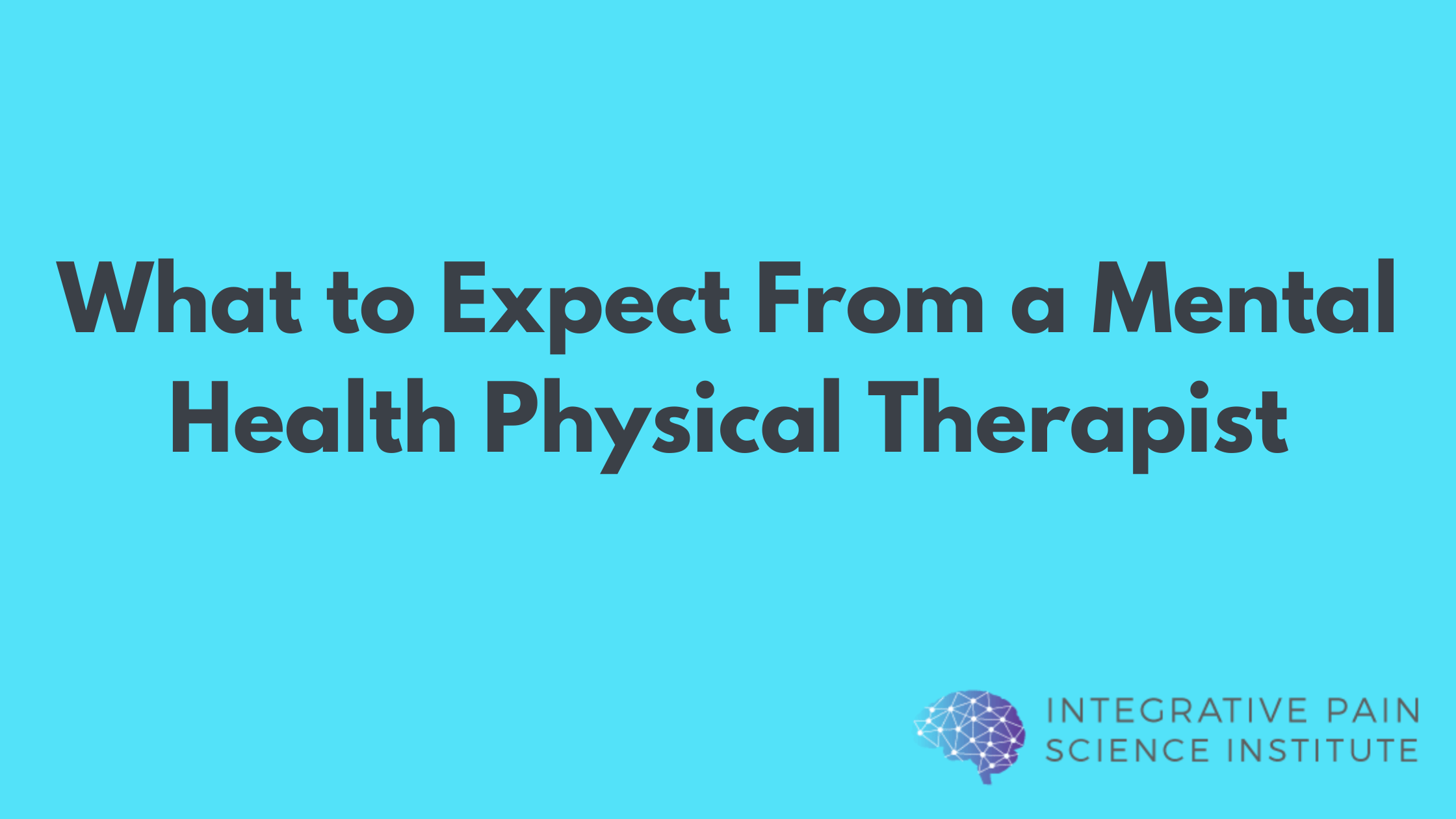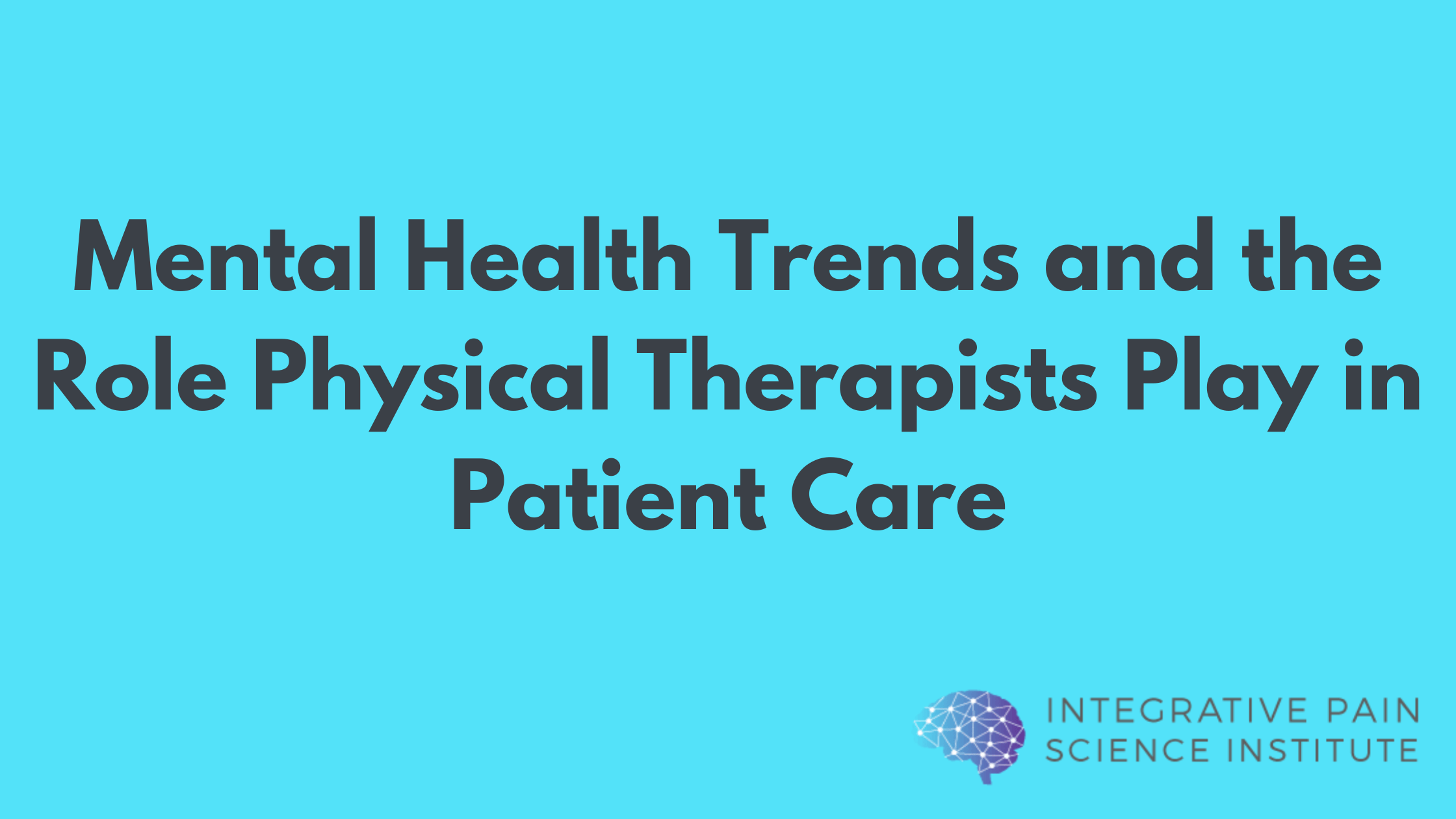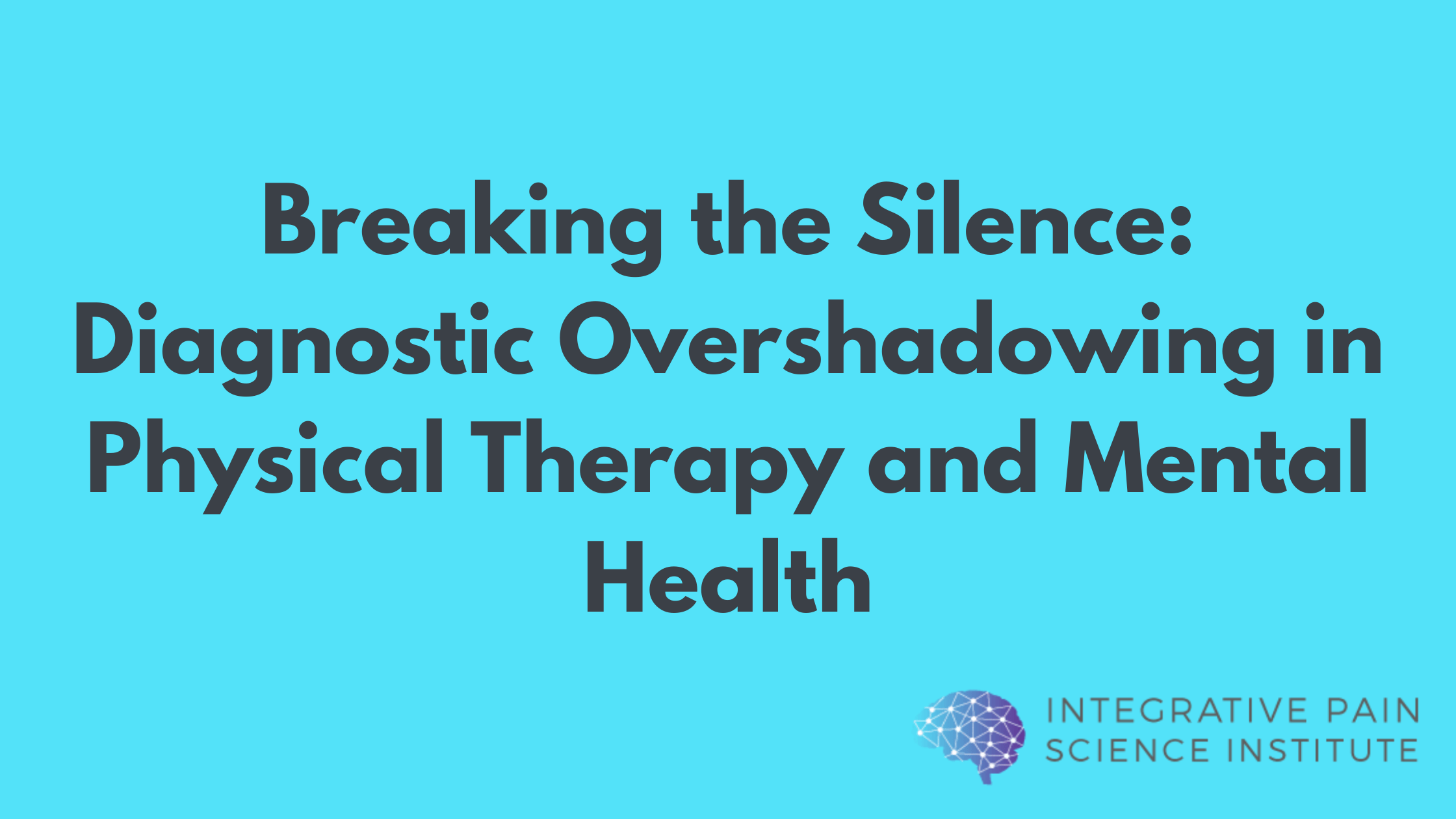Are you ensuring that the language you use when conversing with your patients is having a healing effect? If not, your lack of awareness may be the reason some of your patients have a difficult time managing their chronic pain.
Your words are very powerful and have the ability to heal or harm.
The language you use can have a significant impact on your patients mental and physical well-being. It is crucial that we are mindful of our word choice and tone when communicating. One word can change the entire perception of an experience. As clinicians, we are supposed to be the ones who are encouraging the wellness of others on a biological, psychological, and social level. Awareness of nocebo language is important in all of healthcare, but especially in pain care. The negative impact language has on the health of another person is called the nocebo effect. And it has the ability to worsen pain on both the biological and psychological level (1).
What is the Nocebo Effect?
The nocebo effect occurs when someone may experience adverse side effects as a result of specific stimuli because they already expect that these unwanted side effects could occur.
These expectations most often develop through:
- verbal suggestion
- conditioning
- social observation (2).
The nocebo effect can be provoked through verbal suggestion when patients are told by clinicians that there is a possibility of the development of adverse side effects. Verbal suggestion can condition patients to think or behave in a particular manner based on what the suggestions lead them to believe. If a patient observes another person in pain as a result of a certain stimulus, the patient is more likely to describe similar amounts of pain when they experience the same stimulus. Because they observed the other person’s reaction, it caused them to develop certain expectations as to how they may react.
Nocebo and Placebo Kinship
Your treatment of a patient affects them both specifically and nonspecifically. Your treatment itself can have an impact on the health of your patient, but also the nonspecific aspects of your treatment such as your language and behavior can either elicit a placebo or nocebo effect in the patient (3). Though the concepts of the two are similar, their outcomes are opposite. When there is a placebo effect occurring, the individual experiences positive side effects from specific stimuli due to positive expectations. If someone was given a sugar pill and told that this” medicine” would help them with depression, and they displayed fewer signs of depression, this would be an example of the placebo effect.
The positive expectations of the patient rather than the effectiveness of the pill are what caused the depression to improve. If that same person was given a sugar pill and was told that it could cause them to experience more depression, the patient is more likely to report feeling depressed. Once again, it was the patient’s expectations that caused this response, not the pill. Incorporating verbal suggestion that promotes a placebo effect can be beneficial for aiding patients in overcoming their chronic pain. On the other hand, nocebo language can delay progress in managing chronic pain and possibly worsen the patient’s symptoms.
Restructuring Common Forms of Nocebo Language
Nocebo language has gone unnoticed by many people. Although healthcare should avoid nocebo language, this is ironically one of the places you may see it used the most. Some typical examples of nocebo language used in healthcare can be restructured to encourage the patient:
All of these situations can cause patients to experience unnecessary pain because of the negative expectations they form. As clinicians, we must ensure that we are taking every measure necessary to prevent the nocebo nature of our society from leaking into our clinics. When a patient comes to a session, they should have confidence that their clinician is going to encourage them and give them all of the information and resources necessary to aid in building positive expectations. When a patient is expecting to make progress towards managing their symptoms, you will find that they will recuperate more quickly and efficiently.
Nocebo Language and Chronic Pain
Nocebo language has been directly correlated to the development of chronic pain in numerous studies (4). Because the thoughts and beliefs of a patient can alter their physiology, it is important to control what seeds you may be planting in your patient’s mind. Take the time to build awareness of your word choice, tone, or how past experiences may influence your own beliefs.
Nocebo language has been directly correlated to the development of chronic pain in numerous studies Share on X
Psychological Impact of Nocebo Language
If you are incorporating some of the previously listed forms of nocebo language into your sessions, you may be causing the patient to have negative expectations about the possibility of success from your treatment. Preparing your patients for situations that may be painful, uncomfortable, or difficult may cause them to catastrophize the pain associated with the situation (5). For example, if you explain to a patient that they may experience a burning sensation in the back of their leg when performing a hamstring stretch, they will be more likely to perceive the exercise as painful and less possible to comply. When they perceive the burning sensation from the stretch as pain, they may be inclined to believe that the pain could be a sign of damage and cease to continue the stretch.
 Along with decreasing compliance, nocebo language can cause the patient to believe that their body is weak, brittle, failing or degenerating. Telling your patient that using improper form when bending to pick up something could cause a bulging disk is not an efficient way of correcting movement. The patient may have anxiety around reinjuring their spine. Additionally, if the patient does feel any “pain” in their back while bending, they may be alarmed by the sensation and further avoid movement.
Along with decreasing compliance, nocebo language can cause the patient to believe that their body is weak, brittle, failing or degenerating. Telling your patient that using improper form when bending to pick up something could cause a bulging disk is not an efficient way of correcting movement. The patient may have anxiety around reinjuring their spine. Additionally, if the patient does feel any “pain” in their back while bending, they may be alarmed by the sensation and further avoid movement.
If a patient is diagnosed with arthritis of the knee, that diagnosis can cause them to feel more pain because they have been told that it is “degenerating”. The human body is always working to rebuild and regenerate. This can give the patient the belief that their symptoms are already improving and can improve further by cooperating with the body’s healing process. To prevent fear-avoidance behavior and pain catastrophizing, clinicians must remove the usage of nocebo language from their sessions and replace it with words that will encourage compliance and recovery.
Physiological Impact of Nocebo Language
The brain releases certain hormones when exposed to nocebo language. Cortisol is one of the main hormones your body produces when it is experiencing pain or feels that danger may be present. The presence of cortisol heightens the senses of the body causing pain to be amplified. And living in a state of fear causes chronic stress. There are numerous negative physiological effects that chronic stress can have on the body including (6):
- Muscle Tension (Migraines, Low Back Pain)
- Respiratory complications (Hyperventilation, Panic Attacks)
- Circulatory Stress (Narrowing of arteries, Hypertension, Arrhythmia)
- Impaired Digestion (Decreased Blood Flow to Intestines, Constipation, Loss of Appetite)
Because the conscious and unconscious mind has direct control over all bodily functions, it is vital that clinicians are always aware of how the words they use may affect the mind.
Free Chronic Pain Presentation:
Click here to learn natural ways to heal from pain without prescription medication or surgery.
Social Nocebo Factors

Nocebo language may also be influenced by society. The environment your patient is exposed to on a daily basis has a significant effect on their paradigm of thinking and behavior. Past experiences with other clinicians also sculpt some of the thoughts and beliefs of patients and should be thoroughly considered. If a patient has had unsuccessful previous attempts in managing their chronic pain whether it be through surgery or medicine, they may have a hard time believing that you will be able to help them achieve a different result. Building trust through open discussion of the patient’s concerns is the best way to overcome this issue and remove any negative assumptions.
Out with Nocebo In With Placebo
How can we enhance the placebo effect in our patients and eliminate the possibility of the nocebo effect? The solution is not as complicated as you might think. There are five main methods for leveraging the power of the placebo effect with your patient expediting their pain management including:
- Be Empathetic
- Provide Positive Instruction
- Create Positive Expectations
- Build Positive Client Perception
- Set Up Success Through Priming
By implementing these basic methods into each session, you are laying the groundwork for your patient’s success in overcoming their chronic pain.
Method #1: Build Positive Patient Perception
The second your patient walks in the door, they are already making a judgment on your credibility. They’ve heard stereotypes and may have had previous unsuccessful experiences. One of the keys to building your patients’ perception of you is by communicating effectively. When asked to describe their symptoms, patients are interrupted an average of 18 seconds into their description (7). Being an active listener demonstrates that you care about what your patient is experiencing. Interrupting makes it seem as if you believe your thoughts are more important than the patient’s.
Method #2: Create Positive Expectations
If a patient is continuously exposed to an environment filled with nocebo factors, they are likely to have negative expectations about their ability to reach their pain management goals. To eliminate negative expectations and replace them with positive expectations, a discussion must take place between the clinician and the patient. The clinician must inquire and resolve any concerns. This step is crucial for laying the foundation of an effective pain management program. For example, to instill positive expectations into the mind of your patient when performing a certain stretch, inform them that they may feel a sensation that will slowly begin to ease up as the stretch is being performed. This is more effective than telling the patient that they may feel tension, tightness, or burning when the stretch is being performed because these terms make the stretch sound painful and damaging. By explaining to the patient that the sensation will begin to relax as the stretch progresses, they may be influenced to continue the stretch to experience the relaxation you described.
Method #3: Set Up Success Through Priming
In order for your patient to believe that you have the knowledge and skills necessary to help them manage their pain, you have to believe that you also possess these characteristics. Telling your patient that you are using the best methods for helping them manage their pain primes them to believe that the exercises are going to result in improvement of their chronic pain. If patients do not believe that the exercises they are doing are the best ones available, the exercises will have a minimum effect on their pain. When you have built up trust and are perceived as confident in your abilities, the patient is more likely to believe that you know what is best for helping reach their goals as efficiently as possible. Combining solid therapy techniques with a patient who is primed to believe that success is imminent guarantees that a patient will see results and will be motivated by those results to increase their compliance with your program.
Method #4: Provide Positive Instruction
It is important for clinicians to be mindful in how they approach correcting their patients. As previously mentioned, if you were to tell a patient that improper form when bending can cause a bulging disk, they would be more likely to avoid any daily activity that involves bending forward. This is at the heart of fear-avoidance behavior. Rather than expressing the consequences of utilizing improper form, emphasize the benefits that can come through a consistent exercise program. The goal is to prevent the patient from developing any ideas that suggest they have a weak spine and back.
Method #5: Be Empathetic
Patients come to you and hope you understand their pain. They may have been told by others that they are imagining the pain or over exaggerating. Pain is always real. By putting yourself in your patient’s shoes, you will be able to view their pain from their perspective and make a connection with them. Patients are more likely to comply with their clinicians when they feel that the clinician truly understands the pain they are experiencing.
Minimizing Nocebo Effects
If you have noticed that you are having issues with patient compliance or satisfaction, your language, communication, and rapport is an excellent place to begin in resolving these challenges. Due to social norms, many of us have become numb to many common forms of nocebo. Your words can be the difference in your patient making a full recovery and struggling to make progress.
Remember, reversing pain requires an integrated approach.
If you need help to better understand what to eat, how to move, or how your thoughts and emotions affect your pain, I hope you’ll consider attending my Free Webinar on Healing Pain Naturally.
You’ll learn how to use the power of your mind to heal; as well how nutrition and gentle movement can reverse your pain. Does this sound like something you need?This webinar will provide you with the info to change your life, almost immediately.
Sign-up for the free webinar here (I’ll email you a recording, too!)




